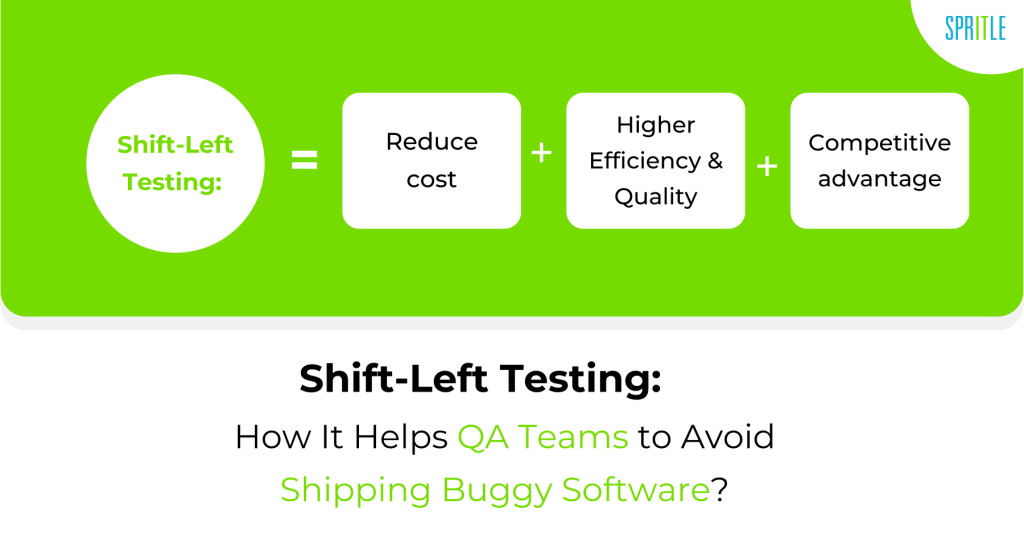
In the dynamic world of software development, maintaining an application’s quality and improving its efficiency is critical. To do this, QA teams employ innovative strategies and methodologies. One such approach that’s gaining momentum in recent years is shift-left testing.
So, how can shift left testing help and assist QA professionals to avoid creating buggy software? Let’s answer this question in this blog post.

Image Source: Google
Understanding Shift Left Testing
Shift left testing is an approach in which the testing steps get performed at the early stages of development, and the QA works with the developers to sort out the issues during the SDLC. They use this approach to fix bugs and produce quality software. Now, having defined Shift Left Testing, let’s figure out why it is one of the best practices for QA.
Why is Shift-Left Testing the Best Approach?
Some of the reasons why shift left testing is one of the best approaches for fixing bugs in the software include:
Early Bug Detection
By moving testing activities to the left of the SDLC, shift-left testing allows for early detection and resolution of defects. This approach minimizes the risk of critical issues arising in the development cycle, which reduces rework. (Reference link – https://www.testim.io/blog/shift-left-testing-guide/)
Improved Communication and Collaboration
Shift-Left Testing promotes better collaboration between QA teams and developers. Regular interaction, collaborative problem-solving, and shared responsibilities lead to improved communication, streamlined alignment, and faster issue resolution.
Enhanced Software Quality
By addressing defects early, shift-left testing significantly enhances the overall quality of the software. This results in an excellent end product that meets customer expectations, and user satisfaction and builds a strong brand reputation.
Accelerated Time to Market
Shift-left testing enables shorter development cycles, resulting in quicker releases and reduced time to market.
Cost Reduction
Catching and rectifying defects early in the SDLC significantly reduces costs associated with rework. Shift-left testing minimizes the chances of defects propagating and impacting subsequent development phases, ultimately leading to cost savings.
How Does Shift Left Testing Help and Assist QA Teams?
Embracing shift left testing will leave QA teams with heaps of insights and benefits like:
Early QA Involvement
Generally, QA professionals engage actively in project discussions from the requirements gathering and design phases. That said, Shift left testing opens the door for QA professionals to Engage themselves early in product development, leading to better product specifications and a reduction in the risk of misunderstandings.
Collaboration and Knowledge Sharing
When QA teams work all along with developers, and stakeholders, enhancing frequent communication, knowledge sharing, and joint code reviews to promote mutual understanding, it ensures the highest quality of the final product.
Test Automation
Using test automation tools and frameworks will accelerate testing activities faster. The Shift-left testing will free up QA teams to focus on more complex scenarios and exploratory testing, resulting in increased test coverage
Why Implement Shift Left Testing For Avoiding Buggy Software?
Now, having explored the benefits shift left testing gives for the QA teams to enjoy, let’s look into how it changes the software testing process for the best!
Continuous Integration & Testing
Combining testing into continuous integration and continuous delivery (CI/CD) pipeline ensures that tests are executed continuously as new code is added, providing quick feedback and identifying early bug detection.
Shift-Left Security Testing
Shift-left principles to security testing identify vulnerabilities, minimize the risk of violation, and ensure the overall integrity and confidentiality of the software.
Performance & Scalability Testing
As part of the shift-left approach for performance and scalability, testing validates the software’s performance characteristics early to identify potential bottlenecks and ensure it can handle the expected user load.
Monitoring & Feedback Loop
Real-time monitoring and feedback gathering allows rapid identification and resolution of performance issues, that ensure smooth user experience.
Best Practices to Make Shift Left Testing Effective
Regularly review & adjust your approach
It should be regularly reviewed and adjusted based on feedback and results. This continuous improvement mindset can help you get the most out of your Shift Left testing efforts
Use Agile Methodologies
Agile methods like Scrum and Kanban encourage early and frequent testing. They promote iterative development, where small pieces of functionality are developed and tested in short cycles, which allow for quick feedback and adjustments.
Leverage Automation
Automation is key to making Shift Left testing practical and efficient. Automated testing tools execute repetitive test cases quickly and accurately, freeing up testers to focus on more complex and exploratory testing.
Futuristic Perspective of Shift Left Testing
So, having looked into the perks and benefits of shift left testing, let’s look into the values it will add to the testing process in the future and channel it to avoid shipping buggy software !
Improved Quality
It improves the overall quality of the application by allowing developers to address potential issues before they escalate
Increased Developer Productivity
By reducing the time spent on fixing bugs, developers can focus more on creating new features and improving the application, enhancing productivity.
Automation and AI Integration
As AI-driven testing can be initiated from the development phase, making the process faster and more accurate with advanced technologies
Conclusion
In conclusion, shift-left testing has emerged as a game-changer for QA teams, empowering them to catch bugs early, improve software quality, reduce costs, and ensure a better user experience. It represents the future of efficient, bug-free software development. That being said, I hope you enjoyed this blog post! If you have any thoughts or questions, please feel free to leave a comment below. I would love to hear from you.
